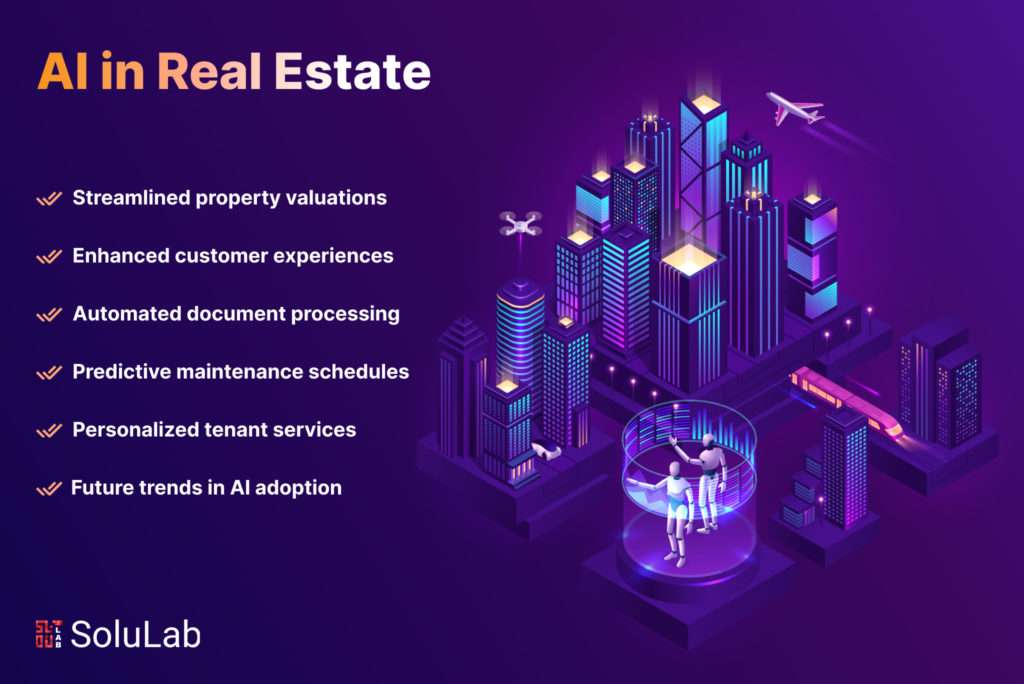The real estate industry faces increasing risks, ranging from natural disasters and market fluctuations to cyber threats and regulatory changes. While adequate to an extent, traditional risk assessment and insurance models often need more agility and precision to address rapidly evolving challenges. This is where artificial intelligence (AI) is revolutionizing how real estate risks are assessed, managed, and insured.
AI-powered tools enable insurers, property owners, and developers to predict and mitigate future risks more accurately. This article explores how AI reshapes real estate insurance and its applications, benefits, challenges, and prospects.
Understanding Real Estate Risks
Real estate properties are exposed to various risks that impact their value, functionality, and insurability. Key risk categories include:
- Natural Risks: Floods, hurricanes, earthquakes, and wildfires.
- Market Risks: Property value fluctuations due to market instability or economic downturns.
- Operational Risks: Maintenance issues, construction defects, or infrastructure failures.
- Technological Risks: Cybersecurity threats in smart buildings.
- Regulatory Risks: changes in zoning laws, taxation, or environmental regulations.
- Social and Political Risks: Civil unrest, vandalism, or policy shifts impacting property rights.
How AI Enhances Real Estate Insurance
AI improves the insurability of real estate by enabling proactive risk management, personalized insurance solutions, and faster claim processing. Here’s how AI achieves this:
1. Advanced Risk Assessment
AI analyzes large datasets from diverse sources, including historical records, satellite imagery, weather data, and property specifications, to identify risk factors more comprehensively than traditional methods.
- Geospatial Analysis: AI processes satellite and drone images to assess risks related to location, such as flood zones or wildfire-prone areas.
- Predictive Models: AI uses machine learning to forecast potential damages based on historical data and current trends.
2. Dynamic Premium Calculation
AI-powered systems enable insurers to offer usage-based and dynamic pricing models that reflect real-time risk levels.
- Example: Properties in hurricane-prone areas might see premium adjustments during hurricane season based on AI-predicted storm activity.
- Personalized Policies: AI customizes policies to suit individual property profiles, offering tailored coverage that balances cost and protection.
3. Real-Time Monitoring
IoT devices integrated with AI systems provide real-time property monitoring, enabling predictive maintenance and immediate responses to threats.
- IoT Integration: Smart sensors detect water leaks, structural issues, or fire hazards, relaying data to AI systems for analysis.
- Actionable Alerts: AI triggers alerts for preemptive action, such as scheduling maintenance or securing properties before extreme weather events.
4. Fraud Detection
AI enhances the efficiency and accuracy of fraud detection in insurance claims by identifying patterns and anomalies.
- Natural Language Processing (NLP): AI tools analyze claim documentation to detect inconsistencies.
- Image Recognition: AI systems verify damaged photos against property records to ensure legitimate claims.
5. Faster Claims Processing
AI-driven automation streamlines the claims process, reducing human error and processing times.
- Chatbots: AI-powered bots handle initial claim submissions, providing instant support to policyholders.
- Automated Adjusters: AI evaluates damages using image analysis and generates settlement amounts quickly.
Applications of AI in Real Estate Insurance
1. Predicting Natural Disasters
AI systems analyze climate data, topography, and historical trends to predict the likelihood of natural disasters and their potential impact on real estate.
- Example: Machine learning models estimate flooding risks by simulating rainfall patterns and drainage capacity.
2. Climate Change Risk Mitigation
As climate change accelerates, AI helps property owners and insurers adapt by forecasting long-term risks, such as rising sea levels or increased wildfire occurrences.
- Example: Coastal properties can be assessed for future flooding risks using AI-driven climate models.
3. Cyber Risk Insurance for Smart Buildings
With the rise of smart buildings, cybersecurity risks are a growing concern. AI enhances the underwriting process for cyber insurance by assessing vulnerabilities in IoT systems.
- Example: AI identifies weak points in building networks and suggests coverage terms based on the likelihood of breaches.
4. Urban Planning and Zoning Compliance
AI analyzes zoning laws and regulatory changes to help insurers evaluate potential legal risks for real estate developments.
- Example: AI flags developments at risk of violating future environmental regulations.
5. Tenant and Market Behavior Analysis
AI predicts tenant behavior, such as default risks or property misuse, and market trends that could influence property values.
- Example: sentiment analysis tools assess tenant feedback to predict occupancy stability.

Benefits of AI in Real Estate Insurance
1. Improved Accuracy
AI-driven models provide granular insights into risks, reducing errors and improving underwriting precision.
2. Proactive Risk Management
Real-time monitoring and predictive analytics allow property owners to address risks before they escalate into costly claims.
3. Cost Efficiency
AI automates repetitive tasks, lowering administrative costs for insurers and making policies more affordable for property owners.
4. Enhanced Customer Experience
From personalized policies to faster claims, AI improves every stage of the insurance process.
5. Reduced Fraud
By detecting fraudulent claims early, AI saves insurers and policyholders from unnecessary financial losses.
Challenges in Implementing AI for Real Estate Insurance
1. Data Availability and Quality
AI models rely on extensive, high-quality data, which may need to be completed or available in some regions.
2. Privacy Concerns
Integrating AI and IoT raises data security and privacy questions, especially in residential properties.
3. Cost of Implementation
Setting up AI systems and IoT infrastructure can be expensive, particularly for smaller insurers or property owners.
4. Regulatory Hurdles
AI-driven insurance models must comply with evolving regulations, which vary by country and region.
5. Overreliance on Technology
While AI is powerful, it should complement human expertise rather than replace it entirely.
The Future of AI in Real Estate Insurance
The adoption of AI in real estate insurance is expected to grow, driven by technological advancements and an increasing focus on sustainability and resilience. Key trends include:
- Blockchain Integration: Combining AI with blockchain could enhance property records and claim processing transparency.
- Green Insurance Models: AI will help insurers offer policies that reward energy-efficient or sustainable building practices.
- Autonomous Claim Handling: Fully automated systems could handle claims end-to-end, from filing to settlement.
- Global Risk Prediction Networks: AI systems could create interconnected networks for international risk sharing and disaster response planning.
AI transforms real estate insurance by enabling precise risk assessment, personalized policies, and proactive management of future threats. By leveraging advanced analytics, IoT integration, and machine learning, AI empowers property owners and insurers to navigate an increasingly complex risk landscape. While challenges remain, the potential for AI to revolutionize how real estate is insured is undeniable, making it a cornerstone of a resilient and adaptive industry.












